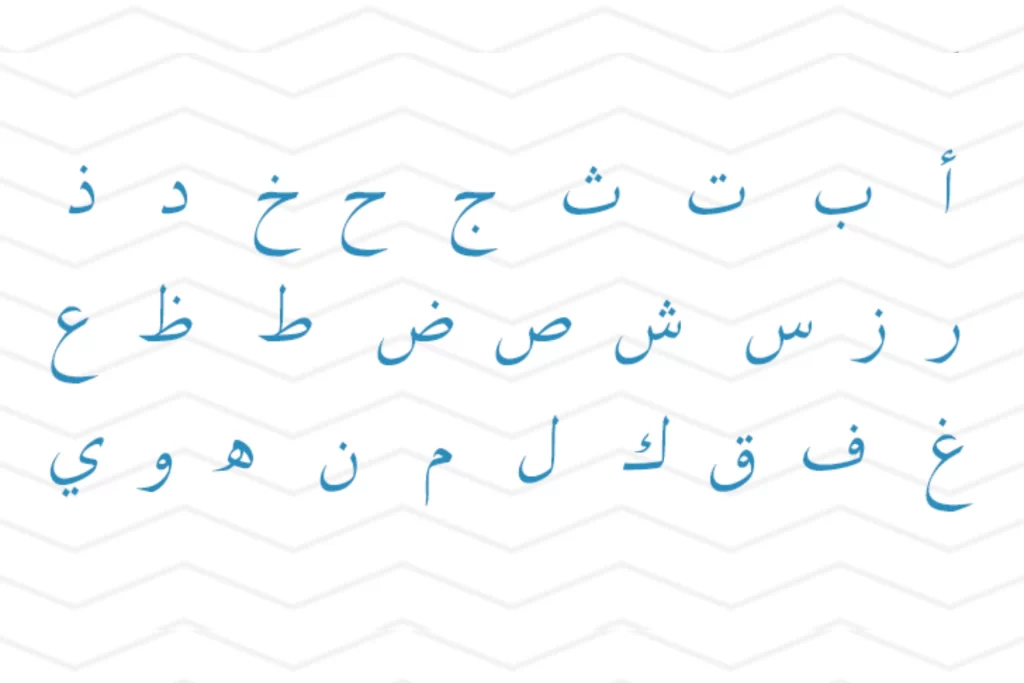Learning the Arabic alphabet is your gateway to unlocking the beauty of Arabic script and immersing yourself in the rich cultural heritage of the Arab world. Whether you’re a student, a traveler, or simply passionate about languages, getting to learn Arabic alphabet will open up a world of opportunities for you.
And because the most important thing to learn a language correctly is learning its Alphabet first, we will take you in this comprehensive guide through 10 easy steps that will help you navigate the Arabic alphabet with confidence. In fact, These steps will help you learn how to pronounce every character in Arabic, how to pronounce different basic words and how to read Arabic.
In This Article:
The Arabic Alphabet: A Fascinating Script
The Arabic alphabet is an exquisite and artistic writing system that has its roots in the ancient Nabataean script. It consists of 28 letters, each with its own distinct shape and sound. The script is written from right to left, adding to its allure and uniqueness.
In Arabic, each letter has three possible forms: the initial form, the medial form, and the final form. This means that depending on the position of a letter within a word, its shape may vary slightly. Understanding these variations is crucial for reading and writing Arabic fluently.
In addition, the Arabic alphabet is an abjad, which means that it does not have any vowels. Instead, vowels are indicated by diacritics, which are small marks that are placed above or below the letters, for example: اللُّغَةُ العَرَبِيَّةُ
Getting Familiar with Arabic Letter Connections

One of the distinct features of the Arabic alphabet is the way letters are connected when writing words. Unlike in English, where letters are mostly written separately, Arabic letters are often joined together, creating a beautiful flow of script.
These connections can be categorized into three types: letters that connect from both sides, letters that connect only from the right, and letters that do not connect at all. Mastering Arabic letter connections is essential for developing a fluid and legible Arabic handwriting style.
10-Step Guide to Learn Arabic Alphabet
1. Learn Arabic Alphabet by Listening to its Sounds:
First of all, making your ears familiar with the letters’ sounds is the best way to learn Arabic Alphabet correctly from the very beginning. With shapes under control, shift focus to pronunciations. Further, this will help you avoid many mistakes throughout your learning journey. Because of this, you have to listen carefully to how the letter is being pronounced and repeat it many times to make sure the sound becomes familiar. Finally, pronounce it correctly without any mistakes and move on to the next step.
2. Use a Word for Every Character in Arabic:
Because learning best feeder is practice, we advise that you pick a word for every character in Arabic and use it on a daily basis in situations, so that you can learn the Arabic Alphabet easily and in a short time, in addition to learning the right usage of the words you have picked.
3. Learn How to Pronounce Every Character in Arabic in Three Positions in the Word:
Every character in Arabic can be put in the word in three positions as we’ve mentioned before (at the start, in the middle, at the end), and it can be all by itself. Therefore, pick three words for every letter that show the sound of the letter in the three different positions in the word. Then, add them to your daily used Arabic vocab, so you can work efficiently on all letter sounds in the language.
4. Learn Arabic Alphabet by Using Flashcards:
You can learn Arabic Alphabet by using flashcards, which is one of the most effective ways to help boost the learning process and shorten the time of it. To do this, add all the Arabic vocab you’ve learned to flashcards with the translation to your language and put a daily or weekly schedule to practice them.
5. Embrace the Beauty of Arabic Calligraphy
Arabic calligraphy is an art form that has captivated people for centuries. It is the visual representation of the Arabic alphabet’s elegance and intricacy. As you progress in your Arabic alphabet learning, take the time to explore the world of calligraphy.
Appreciate the diverse styles and techniques employed by master calligraphers, and even try your hand at it. Engaging in Arabic calligraphy will deepen your understanding of the script’s aesthetic and historical significance. Head to this article to know more about Arabic Calligraphy
6. Recognize the Letter in a Word in a Sentence (in Three Positions):
Also, you can learn Arabic Alphabet by choosing different sentences and trying to recognize the letters you’ve learned in the words in the three positions (at the start, in the middle, at the end).
7. Practice the Words You’ve Learned by Reading and Building Sentences:
Next step is practicing every character in Arabic you have learned by reading the Arabic vocab flashcards you’ve made, several times. Then, try to form meaningful and simple sentences using those words.
8. Assess Your Performance by Revising Arabic Vocab and Sentences:
The last step is to make sure that your learning process comes off, and you can really practice all what you have learned in ease. Read more sentences with new words, try to pronounce words first all by yourself and then check the right pronunciation and tashkeel.
9. Dril with Interactive Worksheet for Arabic Alphabet Activities:
Repetitive activities like worksheets strengthen knowledge by engaging visual, auditory and writing skills simultaneously. For example, tracing, connect-the-dot, fill-in-the-blank, and matching letter games boost focus through play.
Track progress in your personal logbook. Undoubtedly, creative projects instill lasting familiarity while avoiding boredom. This is how learning transforms into a fun routine you look forward to each session!
10. Practice Your Knowledge: Write a Letter in Arabic:
Congratulations! You’ve reached the final step in your Arabic alphabet journey. It’s time to put your newfound skills to use by starting to write a letter in Arabic. Express your gratitude to a friend, introduce yourself to a pen pal, or simply jot down your thoughts in Arabic script.
This exercise will not only reinforce your knowledge of the Arabic alphabet but also allow you to connect with others who share your passion for the language. Embrace this opportunity to showcase your progress and inspire others on their Arabic language learning journey.
Finally, take a look at this table of names, pronunciation of letters and how to write them:
| Letter | Name | Pronunciation |
| أ | a | alif |
| ب | b | ba’ |
| ت | t | ta’ |
| ث | th | tha’ |
| ج | j | jim |
| ح | 7 | 7a’ |
| خ | kh | kha’ |
| د | d | dal |
| ذ | dh | dhal |
| ر | r | ra’ |
| ز | z | zay |
| س | s | sin |
| ش | sh | shin |
| ص | s | sad |
| ض | d | dad |
| ط | t | ta |
| ظ | z | za |
| ع | 3 | 3ayn |
| غ | gh | ghain |
| ف | f | fa |
| ق | q | qaf |
| ك | k | kaf |
| ل | l | lam |
| م | m | miim |
| ن | n | noon |
| ه | h | ha’ |
| و | w | waw |
| ي | y | ya’ |
Conclusion
Learning the Arabic alphabet is an exciting and rewarding endeavor that opens doors to a world of language, culture, and personal growth. By following these 10 easy steps, you will be ready to recognize the Arabic letters and their sounds in ease, learn how to read Arabic full sentences, and get them in context. Also, you will gain confidence in writing and understanding Arabic script.
To sum up, when you learn Arabic Alphabet correctly from the beginning, you put the bedrock for the whole process of your future Arabic language learning which will push you forward everyday in the right way. This is what the new research calls “learning the language by the language itself”.

